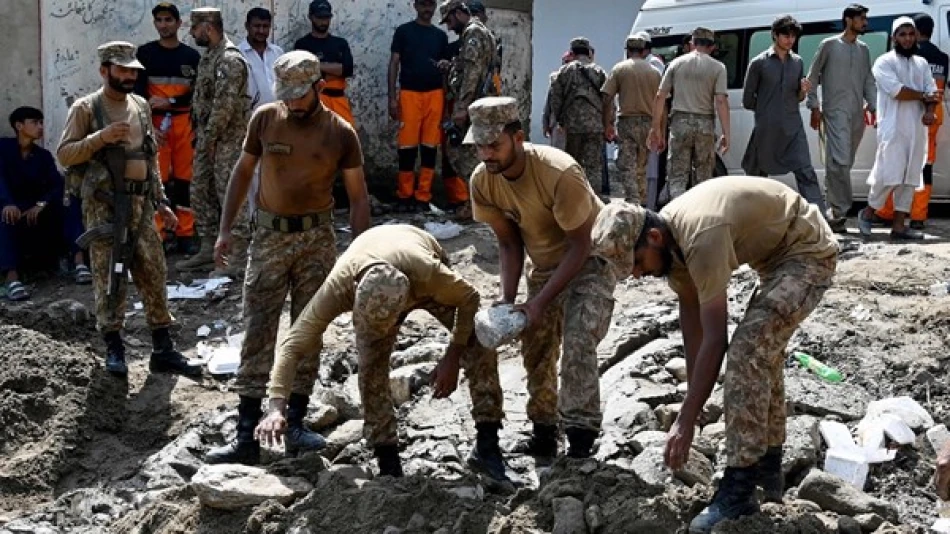
Devastating Floods in Pakistan Leave Dozens Missing: Disaster Relief Efforts Underway
Pakistan's Deadly Floods Expose Critical Gap Between Climate Reality and Urban Planning
As rescue teams continue searching for over 150 missing people in northwestern Pakistan following devastating flash floods, the disaster has sparked a contentious debate about responsibility. With 277 confirmed deaths in the mountainous Buner district alone, senior officials are pointing fingers at residents for building homes in flood-prone areas, while the broader crisis underscores Pakistan's vulnerability to increasingly unpredictable monsoon patterns.
Search Operations Expand as Death Toll Climbs
Emergency services spokesman Muhammad Sohail confirmed that rescue operations have expanded into remote areas of the Buner district in Khyber Pakhtunkhwa province, where Friday's sudden torrential rains triggered catastrophic flooding. The military has deployed engineers and heavy machinery to clear debris as teams recovered three additional bodies on Monday, bringing the local death toll to 277.
More than 150 people remain unaccounted for, swept away by floodwaters that struck with little warning despite existing early warning systems. The scale of the search operation reflects both the severity of the disaster and the challenging mountainous terrain that has complicated rescue efforts.
Government Blames Victims for Settlement Patterns
Provincial Chief Minister Ali Amin Gandapur sparked controversy Sunday by suggesting many deaths could have been avoided if residents hadn't built homes along waterways and riverbanks. His comments highlight a persistent tension in developing nations between immediate housing needs and long-term disaster risk management.
"The government will encourage displaced families to relocate to safer areas, where they will receive assistance in rebuilding their homes," Gandapur stated, outlining plans for managed retreat from high-risk zones.
However, this victim-blaming approach overlooks the complex socioeconomic factors that drive settlement patterns in Pakistan's rural areas, where access to safer land often depends on economic resources many families lack.
Pakistan's Monsoon Crisis Deepens
The Buner tragedy represents just one chapter in Pakistan's broader monsoon disaster. Since June 26, above-normal seasonal rains have killed at least 645 people nationwide, with 400 deaths concentrated in the northwestern regions. The National Disaster Management Authority issued fresh flood warnings Sunday as new rainfall began across multiple provinces.
This year's monsoon pattern echoes the devastating 2022 floods that submerged one-third of Pakistan and affected 33 million people. The recurring severity suggests Pakistan is experiencing a new normal of extreme weather events that existing infrastructure and planning frameworks cannot handle.
Climate Adaptation vs. Immediate Needs
Pakistan's flood crisis illustrates a fundamental challenge facing climate-vulnerable nations: balancing immediate development needs with long-term resilience planning. While officials call for relocating communities away from flood zones, the reality is that riverbanks and valleys often provide the most fertile land and water access for agricultural communities.
The government's promise to assist with relocation and rebuilding will be tested by Pakistan's constrained fiscal resources and competing development priorities. Previous post-disaster reconstruction efforts have often fallen short of promises, leaving communities to rebuild in the same vulnerable locations.
Early Warning Systems Under Scrutiny
Despite government insistence that early warning systems functioned properly, the high casualty count raises questions about the effectiveness of Pakistan's disaster preparedness. The sudden intensity of Friday's rainfall reportedly outpaced the system's ability to provide timely alerts to remote communities.
This points to a critical gap in Pakistan's disaster management: while meteorological forecasting has improved, the "last mile" of warning dissemination and community response remains weak, particularly in mountainous areas with limited communication infrastructure.
As climate change intensifies monsoon variability across South Asia, Pakistan's experience serves as a stark reminder that effective disaster risk reduction requires not just better forecasting, but fundamental changes in how and where communities develop—changes that demand both political will and substantial financial investment.
 Layla Al Mansoori
Layla Al Mansoori







